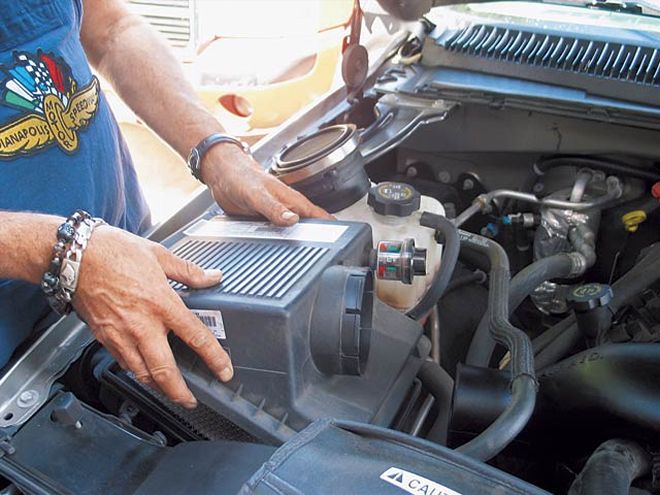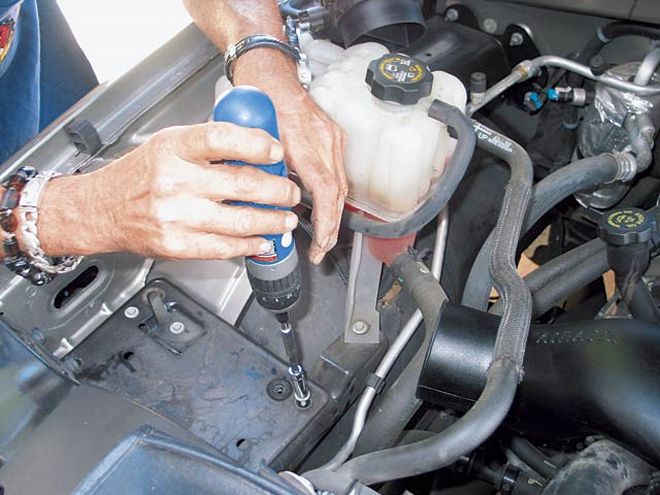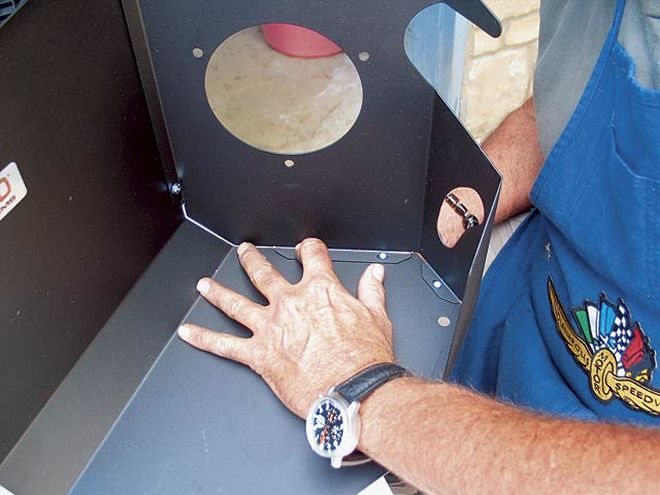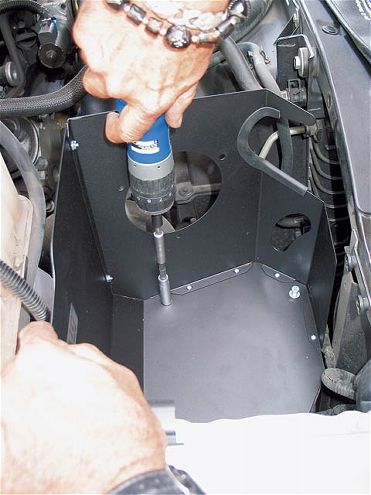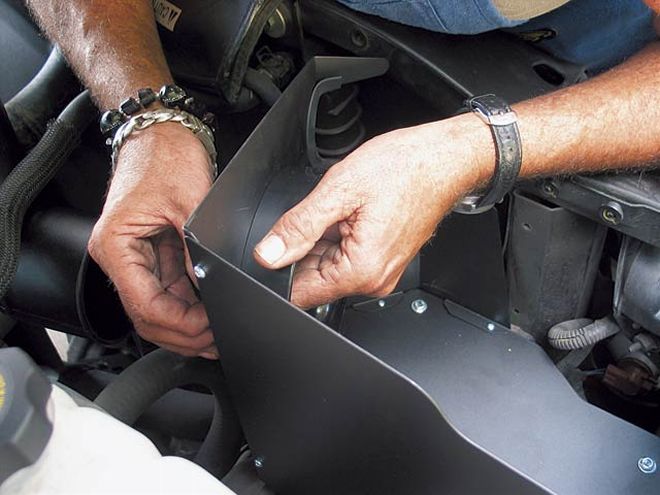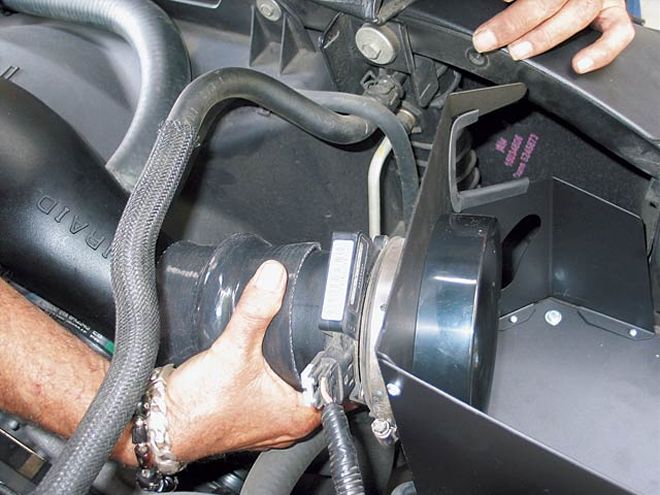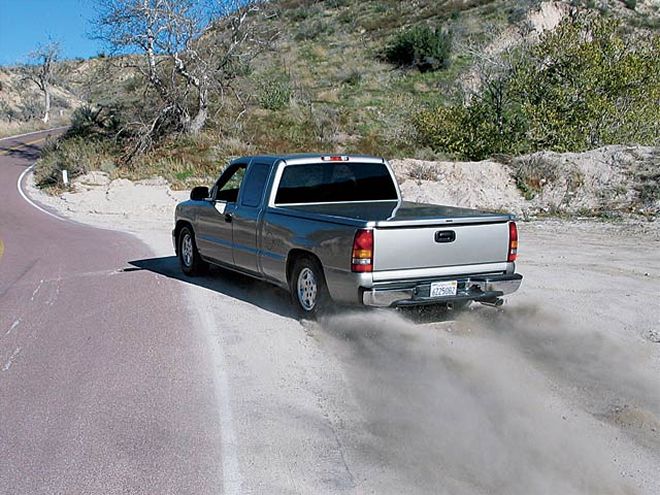
| 132 0504 Combo00 Z
We're all interested in getting more power and mileage from our sport trucks. The question is how to get it.
Two of the most popular bolt-on performance parts are free-flowing intake and exhaust systems. They're popular for a reason - they work. Any time you reduce the work required to get air into and out of the engine, you not only free up power, you make it more efficient. And that means you get the benefit of increased fuel economy.
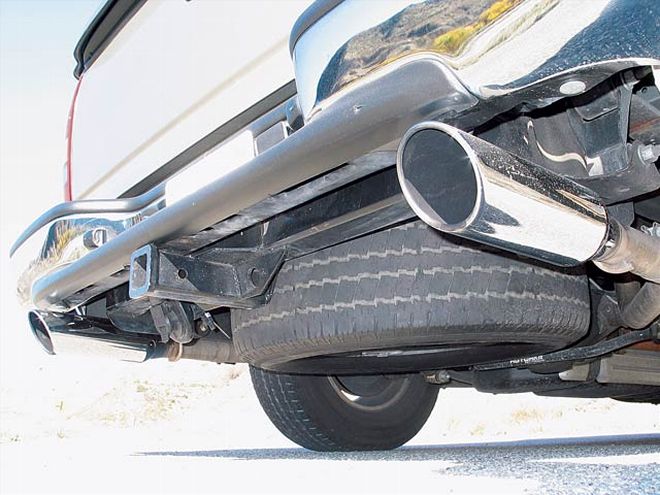
| 1. Borla exhaust systems are high-quality mandrel-bent units featuring proprietary sound management technology that are among the best flowing, best sounding exhausts on the market. The dual rear muffler Borla exhaust system we installed added a tough look and an aggressive rumble to our test truck.
Now since we're talking about two systems here and since most enthusiasts are on a budget, many times we have to choose what to do first. In this case, that's a no-brainer. If you still have the stock exhaust system, you need to step up to a better-flowing exhaust system. We almost always recommend installing a good-flowing aftermarket exhaust as the first mod for any truck.
Why? Because an exhaust system that presents less restriction to the engine does so over its entire operating range, including part-throttle operation. In contrast, intakes tend to be more effective the wider you open the throttle. That's not to say you won't experience a performance increase with a free-flowing intake at part-throttle operation without an exhaust system. You will. But you'll get even more once they're both installed.
In this article, we're practicing what we preach, by first installing a Borla exhaust system and reporting on how the truck responded to the mod. Then we installed an Airaid intake and ran a few performance tests before sending the owner off on his usual street-driving routine for a couple of weeks to get fuel-mileage data.
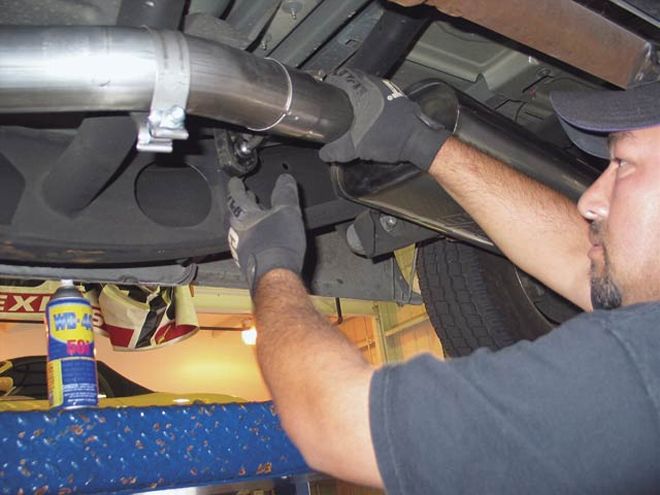
| 2. After removing the stock exhaust system, installing the Borla is essentially the reverse process. The exhaust pipe bolts to the flange, and then you bolt the muffler to the lead pipe. Hang the muffler with the stock hangers, then use the supplied fasteners to secure the connection.
Borla Exhaust SystemEven if all you got from the Borla exhaust system was its wonderful exhaust note, you'd be getting your money's worth. The mellow rumble of the Chevy 5.3L third-generation V-8 through these pipes and mufflers is one of those sounds that truly makes building your sport truck a satisfying experience. The Borla system produces a great sound on the outside, announcing your rig to the world, but at the same time the system is designed to be extremely quiet on the inside. You can still here the tuned exhaust note, but it doesn't cause an annoying resonance, at any point in the rpm band. That's one of the key benefits of this system.
The other key benefits are improved mileage and performance. With the Borla exhaust only, the owner of this test mule says he saw about a 1-mpg improvement in mileage and noticeable increase in mid-to-high-rpm power. So instead of the 10 mpg he was getting before installing the system, he says it improved to about 11 mpg. Curiously, he says that with the Borla exhaust system installed, he noticed that the truck lost a little on the low end, especially off-idle. The truck had more beans in mid to high range, but he felt he lost a little torque on throttle tip-in.
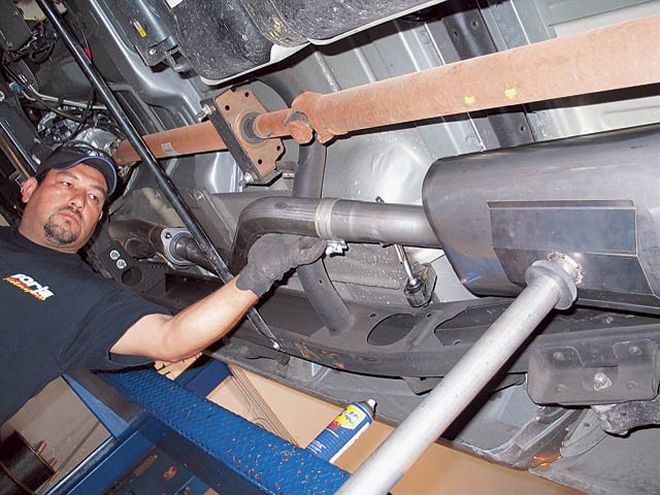
| 3. This view shows how the lead pipe and muffler should look when properly installed.
With Airaid Intake Here's the reason we're always talking about performance combos - parts have to work together. And this concept is proved quite clearly with the intake and the exhaust. After adding the Airaid intake, the owner of this truck says went from an average of 11 mpg in the city to nearly 15 mpg. He also reports that he got 20 mpg on the freeway cruising at 80 mph. But what impressed him most was the improved off-idle throttle response the Airaid system added to this combo.
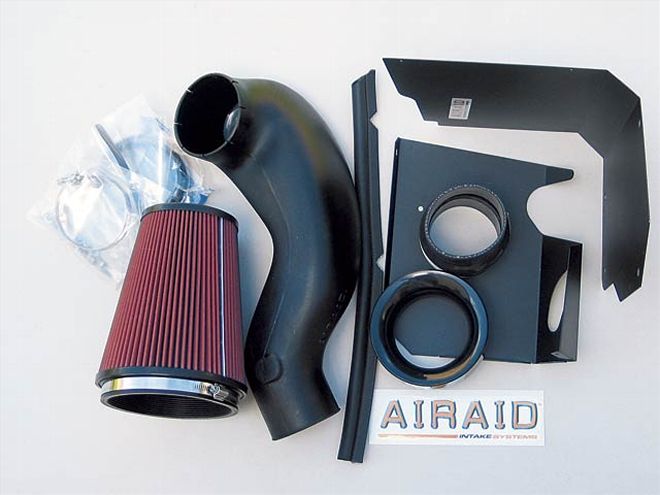
| 7. Airaid makes intake systems for most makes and models of cars and trucks. For the late-model GM product, the system is available for '99 to '05 4.3L, 4.8L, 5.3L, and 6.0L trucks. Read our test to find out if it works.
We didn't put the truck on a dyno, so we don't have horsepower numbers to back up the owner's impression of his truck's response to the mods. But we did check the truck's performance before and after we installed in the intake with a G-Tech. The truck was turning 16.77 at 85 mph before we installed the intake. After we installed the intake, the truck ran 16.69 at 86 mph, nearly a 0.10-second e.t. and 1-mph improvement, or about a 10hp increase at the rear wheels. Keep in mind that these are observed times and we didn't adjust for altitude or barometric changes. We tested the intake in the afternoon, when it was several degrees warmer than the cooler temperatures we had in the morning when we tested the performance of just the exhaust. And we know the intake and exhaust combination would have shown a much higher increase in the cooler air, and a 20hp increase isn't out of the question.
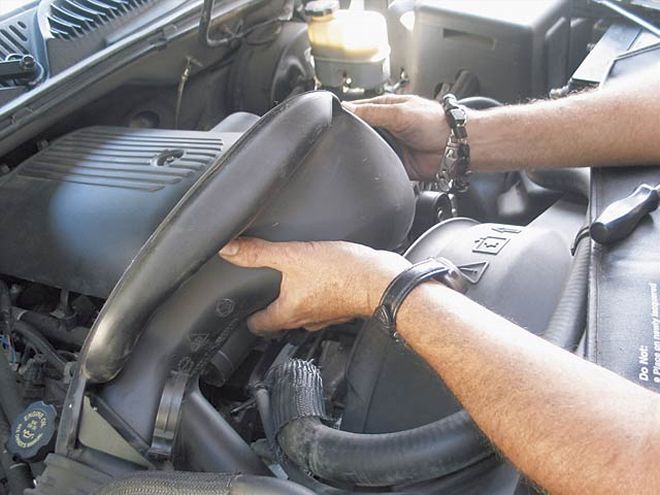
| 8. After disconnecting the negative ground, removing the stock intake tube is one of the harder steps to install the Airaid intake. The kit is well-designed and fits like the factory made it, and goes in easily.
Still, the Airaid and Borla combination produced a lot more tire spin off the line than just the Borla exhaust alone. To our minds, that backs up the owner's observation that the combination is making good low-end torque as well as more top-end power.
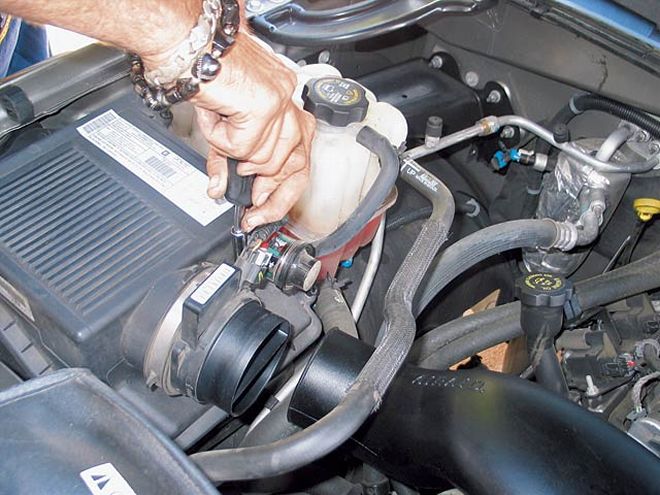
| 9. Next, remove the mass airflow meter by loosening the band clamp securing it to the stock airbox. (Note: The hose clamp and rubber bushing stay on the MAF meter.) Be careful when handling this device. Store it while working in a safe place so it won't get knocked around. Be especially careful of the honeycomb and the heated element.
One other thing we did was use a scan tool to check the intake temperatures compared with the ambient (outside) air temperature. We were surprised to find that the Airaid system actually delivered cooler air to the engine than the stock unit. With the stock unit, driving on the freeway, we measured 74 degrees ambient and 81 degrees in the intake. After installing the Airaid intake system, again driving on the freeway, we measured 79 degrees ambient and 79 degrees on the intake. In stop-and-go driving, we saw about a 2-degree increase in the intake temperature compared with the ambient. We were surprised to see this. We thought for sure the Airaid unit would not induct cooler air than the stock intake. We were pleasantly surprised.
That's all the test information we have on this combo. The next step for you, of course, is to install the gear on your truck. Fortunately, that's a straightforward operation that most sport truck enthusiasts can do with your average set of automotive tools in your garage. You will need a set of jackstands, and a floor jack is the preferred tool to lift your truck onto the jackstands. The only other item you may not have to complete the installation we're doing here is a grinder to provide some clearance between the mufflers and the tow hitch. But other than that, your average set of wrenches and average mechanical skills will do the job.
 | 132 0504 Combo00 Z
We're all interested in getting more power and mileage from our sport trucks. The question is how to get it.
Two of the most popular bolt-on performance parts are free-flowing intake and exhaust systems. They're popular for a reason - they work. Any time you reduce the work required to get air into and out of the engine, you not only free up power, you make it more efficient. And that means you get the benefit of increased fuel economy.
| 132 0504 Combo00 Z
We're all interested in getting more power and mileage from our sport trucks. The question is how to get it.
Two of the most popular bolt-on performance parts are free-flowing intake and exhaust systems. They're popular for a reason - they work. Any time you reduce the work required to get air into and out of the engine, you not only free up power, you make it more efficient. And that means you get the benefit of increased fuel economy.
 | 1. Borla exhaust systems are high-quality mandrel-bent units featuring proprietary sound management technology that are among the best flowing, best sounding exhausts on the market. The dual rear muffler Borla exhaust system we installed added a tough look and an aggressive rumble to our test truck.
Now since we're talking about two systems here and since most enthusiasts are on a budget, many times we have to choose what to do first. In this case, that's a no-brainer. If you still have the stock exhaust system, you need to step up to a better-flowing exhaust system. We almost always recommend installing a good-flowing aftermarket exhaust as the first mod for any truck.
Why? Because an exhaust system that presents less restriction to the engine does so over its entire operating range, including part-throttle operation. In contrast, intakes tend to be more effective the wider you open the throttle. That's not to say you won't experience a performance increase with a free-flowing intake at part-throttle operation without an exhaust system. You will. But you'll get even more once they're both installed.
In this article, we're practicing what we preach, by first installing a Borla exhaust system and reporting on how the truck responded to the mod. Then we installed an Airaid intake and ran a few performance tests before sending the owner off on his usual street-driving routine for a couple of weeks to get fuel-mileage data.
| 1. Borla exhaust systems are high-quality mandrel-bent units featuring proprietary sound management technology that are among the best flowing, best sounding exhausts on the market. The dual rear muffler Borla exhaust system we installed added a tough look and an aggressive rumble to our test truck.
Now since we're talking about two systems here and since most enthusiasts are on a budget, many times we have to choose what to do first. In this case, that's a no-brainer. If you still have the stock exhaust system, you need to step up to a better-flowing exhaust system. We almost always recommend installing a good-flowing aftermarket exhaust as the first mod for any truck.
Why? Because an exhaust system that presents less restriction to the engine does so over its entire operating range, including part-throttle operation. In contrast, intakes tend to be more effective the wider you open the throttle. That's not to say you won't experience a performance increase with a free-flowing intake at part-throttle operation without an exhaust system. You will. But you'll get even more once they're both installed.
In this article, we're practicing what we preach, by first installing a Borla exhaust system and reporting on how the truck responded to the mod. Then we installed an Airaid intake and ran a few performance tests before sending the owner off on his usual street-driving routine for a couple of weeks to get fuel-mileage data.
 | 2. After removing the stock exhaust system, installing the Borla is essentially the reverse process. The exhaust pipe bolts to the flange, and then you bolt the muffler to the lead pipe. Hang the muffler with the stock hangers, then use the supplied fasteners to secure the connection.
Borla Exhaust System
| 2. After removing the stock exhaust system, installing the Borla is essentially the reverse process. The exhaust pipe bolts to the flange, and then you bolt the muffler to the lead pipe. Hang the muffler with the stock hangers, then use the supplied fasteners to secure the connection.
Borla Exhaust System | 3. This view shows how the lead pipe and muffler should look when properly installed.
With Airaid Intake
| 3. This view shows how the lead pipe and muffler should look when properly installed.
With Airaid Intake 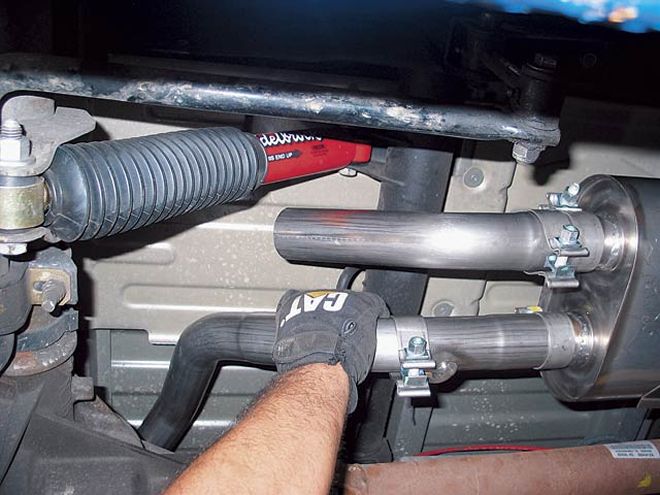
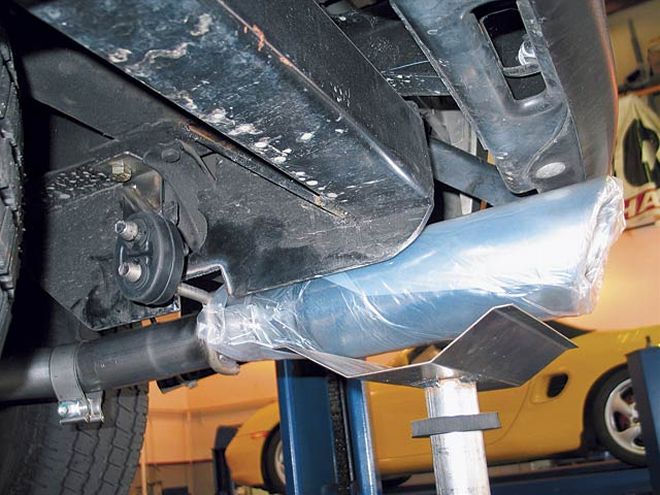
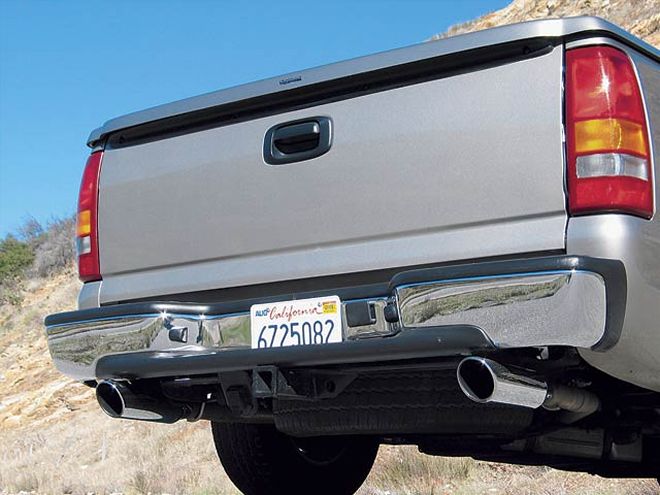
 | 7. Airaid makes intake systems for most makes and models of cars and trucks. For the late-model GM product, the system is available for '99 to '05 4.3L, 4.8L, 5.3L, and 6.0L trucks. Read our test to find out if it works.
We didn't put the truck on a dyno, so we don't have horsepower numbers to back up the owner's impression of his truck's response to the mods. But we did check the truck's performance before and after we installed in the intake with a G-Tech. The truck was turning 16.77 at 85 mph before we installed the intake. After we installed the intake, the truck ran 16.69 at 86 mph, nearly a 0.10-second e.t. and 1-mph improvement, or about a 10hp increase at the rear wheels. Keep in mind that these are observed times and we didn't adjust for altitude or barometric changes. We tested the intake in the afternoon, when it was several degrees warmer than the cooler temperatures we had in the morning when we tested the performance of just the exhaust. And we know the intake and exhaust combination would have shown a much higher increase in the cooler air, and a 20hp increase isn't out of the question.
| 7. Airaid makes intake systems for most makes and models of cars and trucks. For the late-model GM product, the system is available for '99 to '05 4.3L, 4.8L, 5.3L, and 6.0L trucks. Read our test to find out if it works.
We didn't put the truck on a dyno, so we don't have horsepower numbers to back up the owner's impression of his truck's response to the mods. But we did check the truck's performance before and after we installed in the intake with a G-Tech. The truck was turning 16.77 at 85 mph before we installed the intake. After we installed the intake, the truck ran 16.69 at 86 mph, nearly a 0.10-second e.t. and 1-mph improvement, or about a 10hp increase at the rear wheels. Keep in mind that these are observed times and we didn't adjust for altitude or barometric changes. We tested the intake in the afternoon, when it was several degrees warmer than the cooler temperatures we had in the morning when we tested the performance of just the exhaust. And we know the intake and exhaust combination would have shown a much higher increase in the cooler air, and a 20hp increase isn't out of the question.
 | 8. After disconnecting the negative ground, removing the stock intake tube is one of the harder steps to install the Airaid intake. The kit is well-designed and fits like the factory made it, and goes in easily.
Still, the Airaid and Borla combination produced a lot more tire spin off the line than just the Borla exhaust alone. To our minds, that backs up the owner's observation that the combination is making good low-end torque as well as more top-end power.
| 8. After disconnecting the negative ground, removing the stock intake tube is one of the harder steps to install the Airaid intake. The kit is well-designed and fits like the factory made it, and goes in easily.
Still, the Airaid and Borla combination produced a lot more tire spin off the line than just the Borla exhaust alone. To our minds, that backs up the owner's observation that the combination is making good low-end torque as well as more top-end power.
 | 9. Next, remove the mass airflow meter by loosening the band clamp securing it to the stock airbox. (Note: The hose clamp and rubber bushing stay on the MAF meter.) Be careful when handling this device. Store it while working in a safe place so it won't get knocked around. Be especially careful of the honeycomb and the heated element.
One other thing we did was use a scan tool to check the intake temperatures compared with the ambient (outside) air temperature. We were surprised to find that the Airaid system actually delivered cooler air to the engine than the stock unit. With the stock unit, driving on the freeway, we measured 74 degrees ambient and 81 degrees in the intake. After installing the Airaid intake system, again driving on the freeway, we measured 79 degrees ambient and 79 degrees on the intake. In stop-and-go driving, we saw about a 2-degree increase in the intake temperature compared with the ambient. We were surprised to see this. We thought for sure the Airaid unit would not induct cooler air than the stock intake. We were pleasantly surprised.
That's all the test information we have on this combo. The next step for you, of course, is to install the gear on your truck. Fortunately, that's a straightforward operation that most sport truck enthusiasts can do with your average set of automotive tools in your garage. You will need a set of jackstands, and a floor jack is the preferred tool to lift your truck onto the jackstands. The only other item you may not have to complete the installation we're doing here is a grinder to provide some clearance between the mufflers and the tow hitch. But other than that, your average set of wrenches and average mechanical skills will do the job.
| 9. Next, remove the mass airflow meter by loosening the band clamp securing it to the stock airbox. (Note: The hose clamp and rubber bushing stay on the MAF meter.) Be careful when handling this device. Store it while working in a safe place so it won't get knocked around. Be especially careful of the honeycomb and the heated element.
One other thing we did was use a scan tool to check the intake temperatures compared with the ambient (outside) air temperature. We were surprised to find that the Airaid system actually delivered cooler air to the engine than the stock unit. With the stock unit, driving on the freeway, we measured 74 degrees ambient and 81 degrees in the intake. After installing the Airaid intake system, again driving on the freeway, we measured 79 degrees ambient and 79 degrees on the intake. In stop-and-go driving, we saw about a 2-degree increase in the intake temperature compared with the ambient. We were surprised to see this. We thought for sure the Airaid unit would not induct cooler air than the stock intake. We were pleasantly surprised.
That's all the test information we have on this combo. The next step for you, of course, is to install the gear on your truck. Fortunately, that's a straightforward operation that most sport truck enthusiasts can do with your average set of automotive tools in your garage. You will need a set of jackstands, and a floor jack is the preferred tool to lift your truck onto the jackstands. The only other item you may not have to complete the installation we're doing here is a grinder to provide some clearance between the mufflers and the tow hitch. But other than that, your average set of wrenches and average mechanical skills will do the job.
